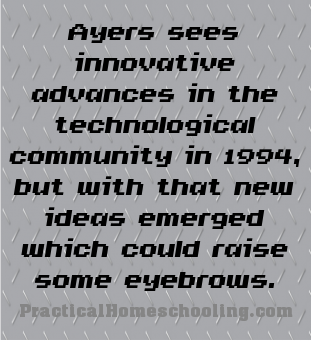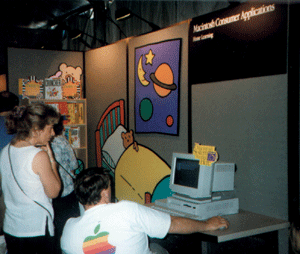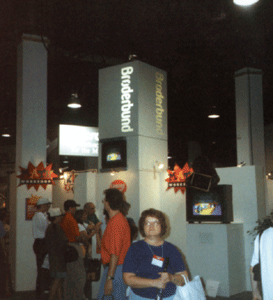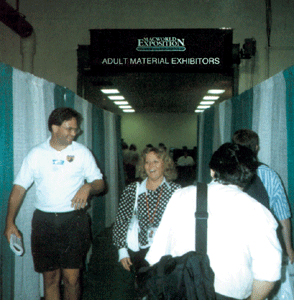 Imagine yourself in a town on the East Coast. You are surrounded by men
with gray-streaked beards, pony-tails, and sandals. They are chatting
amicably with forty-somethings in business suits, young dudes wearing
earrings, and dowdy public school administrators about reconstructing
society based on new thought paradigms. Women with spiked hair and
triple-pierced ears, talking with each other about using Internet to
access nightclub schedules from Paris, strut past ladies with expensive
perms and fake nails. Buddhist programmers debating the merits of
fractal visual-reconceptualization line up at salad bars alongside Rush
Limbaugh conservative dittoheads.
Imagine yourself in a town on the East Coast. You are surrounded by men
with gray-streaked beards, pony-tails, and sandals. They are chatting
amicably with forty-somethings in business suits, young dudes wearing
earrings, and dowdy public school administrators about reconstructing
society based on new thought paradigms. Women with spiked hair and
triple-pierced ears, talking with each other about using Internet to
access nightclub schedules from Paris, strut past ladies with expensive
perms and fake nails. Buddhist programmers debating the merits of
fractal visual-reconceptualization line up at salad bars alongside Rush
Limbaugh conservative dittoheads.
So try a guess: where are you? Certainly not at the Dallas Homeschool
Convention—but where?

|
|
Macintosh children’s exhibit
|
Why, at the MacWorld Expo in Boston! It was a four-day extravaganza of
floor shows and exhibits for every type of Macintosh application
imaginable, from interactive comic books on CD-ROM to accounting
software. Most of the excitement centered on graphics
products—video production software, desktop publishing, art and
computer animation—you name it. Plus informative training
workshops, seminars, and lectures. And of course, lots of floor prizes.
Several times a year in different cities around the country, tens of
thousands of Apple loyalists converge on exhibit halls to revel in the
delights of their beloved Mac. They come to see its latest offerings,
and to explore the marvels of its creative power. They come to examine
new Macintosh software and peripherals that push back every conceivable
technological boundary. They come to be dazzled. And they come to
express and reinforce their loyalty to this most amazing of all
computers and its pleasing, highly-integrated GUI (graphical user
interface).
The Boston MacWorld Exposition from August 2–5 was no different.
At least 50,000 participants came to hear scores of presentations and
look over products from about 450 exhibitors.
We’ve heard complaints about the paucity of software and support
for the Mac. But there was certainly too much to look at thoroughly in
four days. And no type of application, from spreadsheets and word
processors to high-end graphics packages, was missing.
Many of us have heard rumors about the imminent demise of Apple.
Maybe—but there was certainly plenty of excitement, loyalty, and
buying power in evidence at Boston MacWorld. After all, this was the
year of the new System 7.5, an operating system full of neat features.
These include drag-and-drop printing (you drag a document icon over to a
printer icon, and there it goes!), enhanced manipulation of graphical
images, and a “coaching” style Help system called
“Apple Guide.”

|
|
Brederbund”s exhibit
|
Most especially, this was the year of the RISC-processor and the new
PowerMac computer built around it. Power Macs were everywhere,
stimulating awe and fascination in everyone who stopped to play with
them. The RISC promises to handle complex operations more quickly than
the processors used to build PCs and old-style Macs. And it promises to
do this with a far simpler design that ought to sell cheaper, run
cooler, and upgrade further. Even sympathizers of the
“other” guys—the familiar 386 to 586 Intel
processors—admit that by the end of the millennium RISC will be
dominant over standard Mac or PC processors. As leaders in putting RISC
on the desktop, Apple clearly has an opportunity to expand its market,
and reshape personal computing.
Software company leaders made it clear that they were rushing to provide
so-called “native RISC” versions of their products,
applications which will be designed to take advantage of RISCs’
unique capacities. These will have more features, speed, and power than
current versions. Some companies, such as WordPerfect, already had them
for sale. Other RISC upgrades, such as PhotoShop and Excel, will be
shipping soon.
One interesting application for RISC that impressed everyone was a
so-called “intelligent agent.” This software lives inside
your computer, gets to know you, and learns to do things on its own.
One such agent being demonstrated, called Open Sesame, could learn a
user’s habits and modify his computer to conform to them.
Let’s say that when you turn on your computer in the morning, you
usually check your email and then open your calendar. After observing
you doing this for awhile, Open Sesame will verbalize (using sound) what
sequence it “thinks” you like to execute at the beginning of
each day, and suggest you let it automate that. If you tell it
“OK,” it will then go through that sequence of events each
time you turn on your computer. Open Sesame’s developer said that
someday he hopes to make his “agent” capable of observing
and adjusting external environments as well. This could mean controlling
your stereo to play the type of music you prefer to accompany various
times or tasks. Imagine—automatic Bach to accompany your
letter-writing, and something with more of a beat to speed-up your data
entry!
In addition to getting to look at all this “gee-whiz” stuff,
for the $120 full-registration fee you had your choice of a lot of fine
workshops. Registrees enjoyed real training bargains over the costs of
taking the same classes elsewhere. The best were MacAcademy’s,
which ran beginner’s to intermediate-level workshops for such
applications as PageMaker, Word, Excel, and System 7. Other expert
trainers had classes on subjects such as desktop publishing, video
production, animation, and Mac programming.
Disappointing exception: the workshops on educational applications.
Every educators’ workshop yours truly attended was terrible. The
speakers were plodding. Everything they discussed could have been
learned by reading newspaper ads, looking at software boxes, or stopping
by an exhibitors’ booth. And nothing was Mac-specific! Except for
Hypercard—which is old news—nothing was described that would
not have been done just the same on PCs.
Apple has made the educational niche a major target for two decades. It
is hard to believe that they could not have found more educational
applications and ideas unique to “Mac-educating.”
There were a few other “downers” as well.
First, in spite of all the excitement, hope and new technology, there
was real apprehension among many of the experts at the MacWorld Expo
regarding the future of Apple. The problem is this: years of high Apple
prices have driven away willing buyers, and Apple’s closed
architecture has made it impossible for competitors to produce low-cost
versions of the Mac, as clone-manufacturers have done with IBM’s
PC. This has reduced the size of the installed base of Mac machines,
making developers less eager to create products for it. Many people now
have to be convinced to switch to Apple, even as current and future
Windows offerings narrow the ease-of-use gap between PC and Mac. This is
a tall order. But if Apple can not lure these folks away from the PC,
industry expert Pieter Hartsook says, “Apple’s going to wind
up being a niche player,” selling mainly to educators, artists,
and desktop publishers. Graphics and publishing are fun. But they are
not the meat-and-potatoes of business or home computing, and PCs can do
them pretty well.
During the conference a respected Apple analyst admitted to a small
gathering of industry invitees that this fear was widespread at Apple.
The die would be cast within 60 days. Apple’s only hope for
increasing market share was to find some major companies willing to
manufacturing PowerMac “clones” soon. Imagine—Apple
Computers reduced to begging developers to make RISC clones to compete
with their own system and drive down costs!

|
|
TOO MUCH was “expo”sed at MacWorld Expo!
|
There was a second “downer”—pornography and lewdness.
Planning on attending a future MacWorld Expo? Thinking of taking your
children? Than you better exercise some caution, if not reconsider.
In the first official presentation of the Expo, a star panel of industry
experts and executives degenerated into bestiality jokes which, once
started, appeared on and off for about a half hour. Poor taste, to say
the least.
There was also plenty of “interactive erotica.” Computer
porn was kept in a separate area of the expo hall. But huge, explicit
signs hanging from the ceiling made sure that all interested parties
would find their way there without difficulty. MacWorld’s reasons
for segregating the smut, instead of keeping it on the main floor as in
years past? Officials said that other exhibitors complained that the
erotica distracted their customers and harmed sales! Come on
MacWorld—just get rid of this filth!
The Digital Queers booth, representing a “national organization
that provides the queer community with technology tools for greater
communication and productivity,” and openly frequented by
homosexual couples, was also quite a sight. Just what we
need—promotions for a group whose mission is to increase the
effectiveness of homosexual activists. This reminded yours truly of the
strong resistance launched by Apple in Austin, Texas, to anti-sodomy
laws. Their reason? Apple policy gives homosexual couples all the
benefits enjoyed by legitimate marriage partners.
The last downer was that the worldview promoted at MacWorld, where
evident, was decidedly humanistic. This was most glaringly obvious in
the keynote speech, delivered to a packed hall by physicist Stephen
Hawking. Hawking, the author of A Brief History of Time, is stricken
with Lou Gehrig’s disease, bound to a wheel chair, and can only
speak by aid of a computer and voice synthesizer. He has concentrated
on proving that the “God-hypothesis” is unnecessary to
account for the development of life.
Hawking recited his “history and future of the universe,”
starting with the Big Bang 14 billion years ago, and ending with total
breakdown of the natural order about 15 billion years from now.
Then, he delivered the crux of his “hope for the future.”
Mankind would improve itself into a super race through aggressive
genetic engineering— “self-designed evolution.” Those
who do not submit will “die out or become unimportant.” The
new homo sapiens will then colonize space. But given time constraints
such as the 100,000 light-year distance from Earth to the center of our
Milky Way, even supermen will not get far. His solution: create
mechanical life forms with consciousness and the ability to reproduce.
This will make us like gods—since this would be “real”
life—though man will die out before these androids. They would,
however, be immortal, capable of colonizing the whole universe, and even
of surviving its breakdown 15 billion years hence.
Hawking’s plan for human destiny finished with a presentation of
his Brief History of Time CD-ROM, and a standing ovation.
Given all the good things that were to be learned and seen at MacWorld,
as well as the quality of the computers themselves, we are presented
with a quandary. Do we go to events like MacWorld Expo to partake of the
good while avoiding the wretched garbage sprinkled here and there? Or
should we avoid these events altogether? Obviously many Christians have
taken this last approach—the only explicitly Christian products
out of about 450 exhibitors were Zondervan’s MacBibles!
But perhaps avoiding such events is not the answer. Maybe Christians,
and the homeschooling community, should be at places like these in
strength. Maybe we should be promoting our products in effective,
family-friendly, attractive booths at shows such as MacWorld. Perhaps we
should be developing and presenting new software, great ideas, and
compelling visions for the future, based on God’s Word.
Let’s think about it.